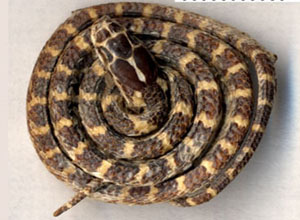Qi She
The Processing of Qi She
Origin
The dried body without viscera of Agkistrodon acutus (Guenther) of family Crotalidae.
Location
Hubei, Jiangxi and Zhejiang provinces, etc.
Harvest
Collected in summer and autumn.
The actual smell and taste
Fishy in smell and slightly salty in taste.
Best quality
Dried and big body with head and tail, obvious figure and speckle.
Processing
Its belly is opened and the viscera is removed, the rest body is dried, its head and lepis is threw away; cut into segments, used without preparation, or stir-baked with wine for use, or moistened with yellow rice wine, then cut into segments and used after the bone is removed.
The Effect of Qi She
Property
Pungent, sweet, warm; liver meridian entered.
Actions
Dispel wind-damp, sooth tendons and activate collaterals, dispel wind to relieve itching.
Indications
A. Arthralgia syndrome due to wind, dampness and cold
With the nature of pungent, warm, moving and unblocking, entering into organs interiorly and extending to muscle and skin exteriorly, it has strong effects of dispelling wind dampness which is rated as "dispelling wind and penetrating bones", and is indicated for all syndromes of arthralgia syndrome due to wind and dampness.
Since it excels in soothing tendons and activating collaterals, it is the essential herb for treating obstinate arthralgia due to wind and dampness, persistent unhealing, spasm and pain of joints and insensitive limbs, and often combined with other wind-damp-dispelling herbs, and blood-nourishing and collaterals-unblocking herbs, for instance, Qiang Huo, Dang Gui and Tian Ma, as in Bai Hua She (Qi She) wine from Bin Hu Ji Jian Fang (Collection of Simple Prescription from Pinhu).
B. Hemiplegia due to windstroke
It is also the essential herb for soothing tendons and activating collaterals. For stagnation of qi and blood after windstroke, obstruction of vessels and collaterals, and malnutrition of muscles and skin which is manifested by wry of eye and mouth, hemiplegia, numbness of hands and feet, and dysphasia, it is combined with qi-replenishing and blood-nourishing, collaterals-unblocking and stasis-resolving herbs, such as Huang Qi, Dang Gui and Di Long,etc.
C. Pruritus
It has better actions of dispelling wind to relieve itching, and can be used in treating pruritis caused by various kinds of dermal diseases such as urticaria, neurodermatitis, etc. Other related herbs for dispelling wind, removing dampness or nourishing blood should be combined according to different condition of predominance of pathogenic wind, dampness, or blood deficiency, for example, Jing Jie and Bo He, or Di Fu Zi and Bai Xian Pi, or Dang Gui and He Shou Wu, etc.
In addition, it also has the action of stopping convulsions, and can be used in treating spasm and convulsions due to acute or chronic infantile convulsion and tetanus, and often combined with other wind-extinguishing and convulsion-stopping herbs.
Dosage and Administrations
Decoct 3~9g; or ground into powder and take l.5~3g orally for each time, twice to three times a day; or used in pill, soaked in wine.
